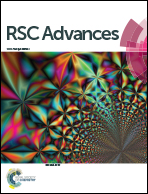Detection of Epstein–Barr virus infection in cancer by using highly specific nanoprobe based on dBSA capped CdTe quantum dots†
Abstract
By using denatured bovine serum albumin (dBSA) molecules as multidentate ligands, surface-functionalized CdTe quantum dots (QDs) were synthesized and further evaluated for preparing fluorescent probes capable of detecting Epstein–Barr virus infection. The optical studies revealed that the dBSA coating effectively improved the optical stability of the resulting QDs (CdTe@dBSA). The interaction between CdTe@dBSA and the membrane of carcinoma cells further suggested that the nonspecific adsorption of CdTe QDs stabilized by thioglycolic acid (TGA) was significantly eliminated upon the dBSA coating. Streptavidin was covalently conjugated to CdTe@dBSA to endow the QDs with specific binding affinity in detecting the serum level of anti-Epstein–Barr virus (EBV) capsid antigen IgA (VCA-IgA) in nasopharyngeal carcinoma patients for early screening and diagnosing EBV-associated cancers.


 Please wait while we load your content...
Please wait while we load your content...